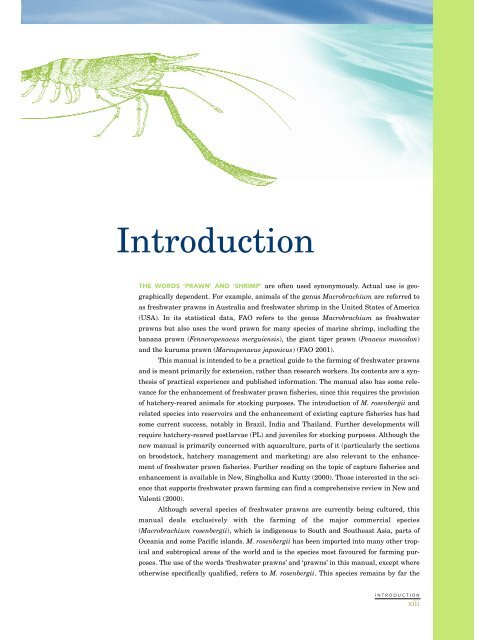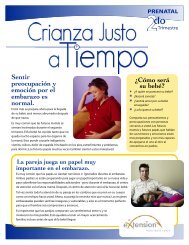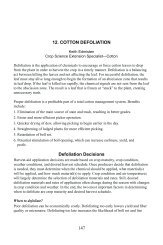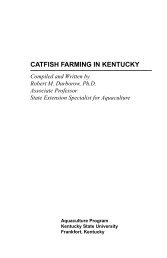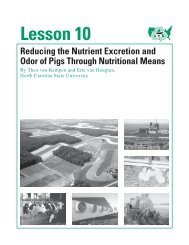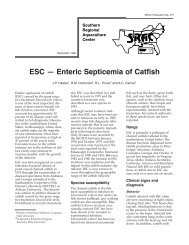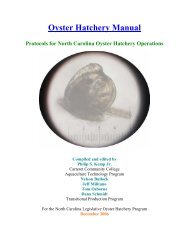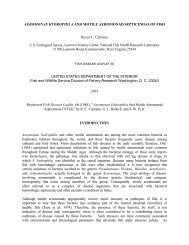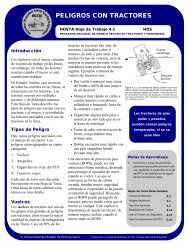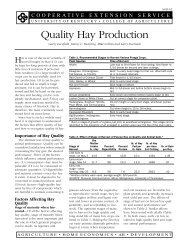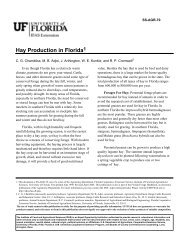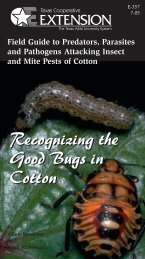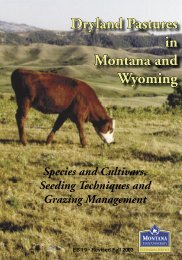Farming freshwater prawns A manual for the culture of ... - eXtension
Farming freshwater prawns A manual for the culture of ... - eXtension
Farming freshwater prawns A manual for the culture of ... - eXtension
You also want an ePaper? Increase the reach of your titles
YUMPU automatically turns print PDFs into web optimized ePapers that Google loves.
Introduction<br />
THE WORDS ‘PRAWN’ AND ‘SHRIMP’ are <strong>of</strong>ten used synonymously. Actual use is geographically<br />
dependent. For example, animals <strong>of</strong> <strong>the</strong> genus Macrobrachium are referred to<br />
as <strong>freshwater</strong> <strong>prawns</strong> in Australia and <strong>freshwater</strong> shrimp in <strong>the</strong> United States <strong>of</strong> America<br />
(USA). In its statistical data, FAO refers to <strong>the</strong> genus Macrobrachium as <strong>freshwater</strong><br />
<strong>prawns</strong> but also uses <strong>the</strong> word prawn <strong>for</strong> many species <strong>of</strong> marine shrimp, including <strong>the</strong><br />
banana prawn (Fenneropenaeus merguiensis), <strong>the</strong> giant tiger prawn (Penaeus monodon)<br />
and <strong>the</strong> kuruma prawn (Marsupenaeus japonicus) (FAO 2001).<br />
This <strong>manual</strong> is intended to be a practical guide to <strong>the</strong> farming <strong>of</strong> <strong>freshwater</strong> <strong>prawns</strong><br />
and is meant primarily <strong>for</strong> extension, ra<strong>the</strong>r than research workers. Its contents are a syn<strong>the</strong>sis<br />
<strong>of</strong> practical experience and published in<strong>for</strong>mation. The <strong>manual</strong> also has some relevance<br />
<strong>for</strong> <strong>the</strong> enhancement <strong>of</strong> <strong>freshwater</strong> prawn fisheries, since this requires <strong>the</strong> provision<br />
<strong>of</strong> hatchery-reared animals <strong>for</strong> stocking purposes. The introduction <strong>of</strong> M. rosenbergii and<br />
related species into reservoirs and <strong>the</strong> enhancement <strong>of</strong> existing capture fisheries has had<br />
some current success, notably in Brazil, India and Thailand. Fur<strong>the</strong>r developments will<br />
require hatchery-reared postlarvae (PL) and juveniles <strong>for</strong> stocking purposes. Although <strong>the</strong><br />
new <strong>manual</strong> is primarily concerned with aqua<strong>culture</strong>, parts <strong>of</strong> it (particularly <strong>the</strong> sections<br />
on broodstock, hatchery management and marketing) are also relevant to <strong>the</strong> enhancement<br />
<strong>of</strong> <strong>freshwater</strong> prawn fisheries. Fur<strong>the</strong>r reading on <strong>the</strong> topic <strong>of</strong> capture fisheries and<br />
enhancement is available in New, Singholka and Kutty (2000). Those interested in <strong>the</strong> science<br />
that supports <strong>freshwater</strong> prawn farming can find a comprehensive review in New and<br />
Valenti (2000).<br />
Although several species <strong>of</strong> <strong>freshwater</strong> <strong>prawns</strong> are currently being <strong>culture</strong>d, this<br />
<strong>manual</strong> deals exclusively with <strong>the</strong> farming <strong>of</strong> <strong>the</strong> major commercial species<br />
(Macrobrachium rosenbergii), which is indigenous to South and Sou<strong>the</strong>ast Asia, parts <strong>of</strong><br />
Oceania and some Pacific islands. M. rosenbergii has been imported into many o<strong>the</strong>r tropical<br />
and subtropical areas <strong>of</strong> <strong>the</strong> world and is <strong>the</strong> species most favoured <strong>for</strong> farming purposes.<br />
The use <strong>of</strong> <strong>the</strong> words ‘<strong>freshwater</strong> <strong>prawns</strong>’ and ‘<strong>prawns</strong>’ in this <strong>manual</strong>, except where<br />
o<strong>the</strong>rwise specifically qualified, refers to M. rosenbergii. This species remains by far <strong>the</strong><br />
INTRODUCTION<br />
xiii


